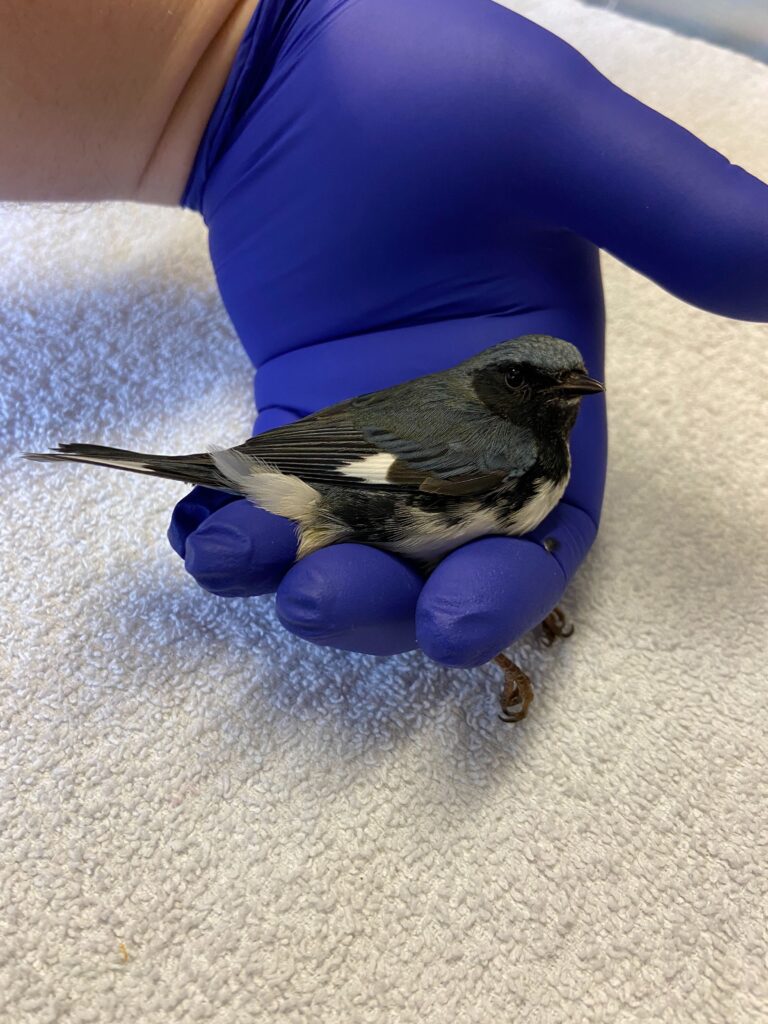
A towel, some gloves, and a cardboard box are all you need to help rescue window-strike victims like this black-throated blue warbler.
It’s fall migration season- do you have your bird rescue kit ready?
During the summer, if you come across a bird on the ground that can’t fly, it’s often safe to assume that bird is a baby. But during spring and fall migration, birds that are found on the ground that do not fly away are frequently adult migratory birds that have struck a window or become disoriented and are in need of human help.
Many migratory birds do most of their travelling at night, when they use the light from the moon and stars, reflections from bodies of water, and even particular sounds to help them navigate their way to their winter grounds down south. Bright lights of urban areas, especially those that extend high into the sky such as skylights and skyscrapers, are particularly dangerous. The most common places to find these birds will be early in the morning on the sidewalk below tall city buildings, but you may find them sitting below the windows of your home and business as well.
Remember- the head and spinal trauma that can result from colliding with a window at high speed is a medical emergency! Common signs of collision include: looking “puffed up”, squinting eyes, squatting down instead of standing upright, and neurologic signs like trembling or a head tilt. Rapid action is so important to the bird’s survival.
Here’s what to do if you find a bird on the ground that you suspect may have hit a window. First, have a “rescue kit” ready so you can act quickly if you see a bird in distress. Keep the following items handy in your car or bag: a paper bag or a small cardboard box with a lid, a tea towel, old t-shirt, or small blanket, and a pair of gloves. They are small things to have, but they can help to save a bird’s life!
Be sure to approach the bird slowly and from a safe angle. Even if a bird is stunned, they may still have limited ability to fly so we don’t want them to fly into traffic or back into a window or building again! As soon as you are close enough, drop a small towel or cloth down over top of the bird, completely covering the head and wings. This will help to reduce stress and keep the bird calm. While wearing gloves, pick up the bird in the towel and place them in the paper bag or cardboard box. Fold the top of the bag down and secure it with a paperclip, or close the lid of the box. This is very important- the bird is likely in shock, and needs to be kept as quiet and stress-free as possible during transport.
As with any injured animal, do not try to give them food or water. A bird with head trauma could drown or choke if they can’t properly hold up their head, and eating improper food items can cause serious medical issues. Keep the bird in a quiet, dark place and transport them to your closest wildlife rehabilitation centre as soon as possible.
Migratory bird populations are declining all over the world due to climate change, habitat destruction, and human-caused conflicts like window strikes. Keep your eyes open and your rescue kit ready, and be a hero to the birds!
By Rebecca Michelin, CWR | Wildlife Rehabilitation Consultant
